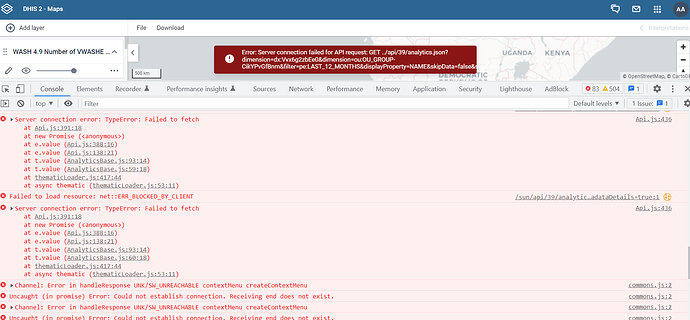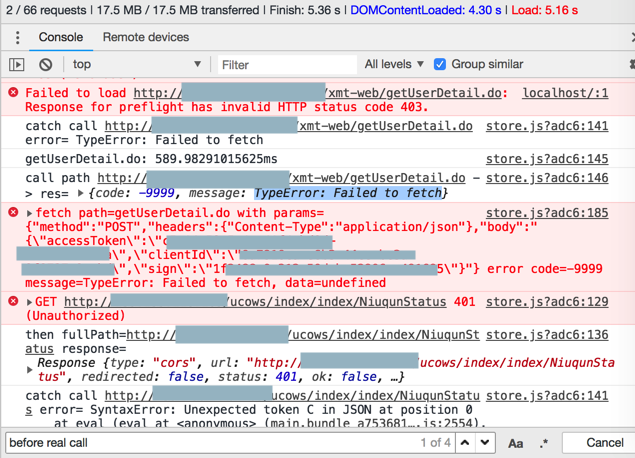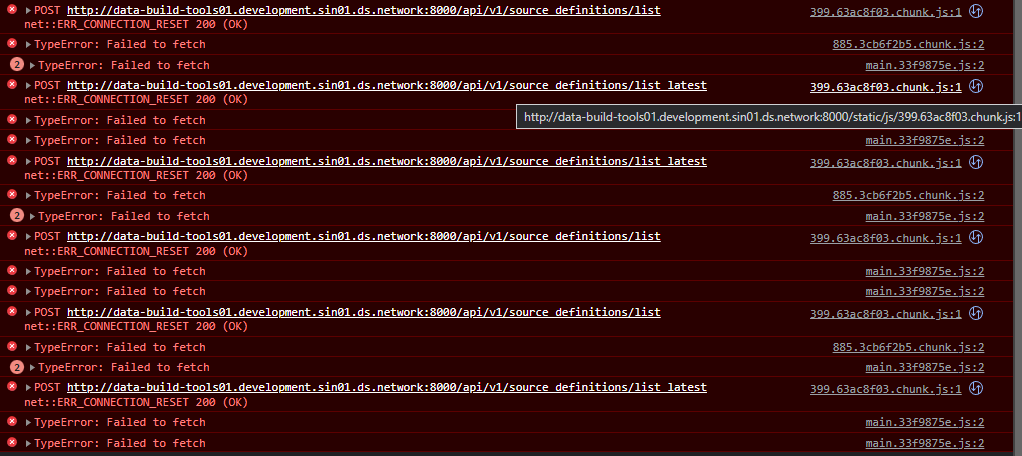Typeerror Failed To Fetch
The “TypeError: Failed to fetch” error is a common issue encountered by developers and users alike when working with web applications and APIs. This error occurs when a request to fetch resources from a server fails. It can occur due to various reasons, including network connectivity issues, incorrect URLs or endpoints, server-side errors, or unauthorized access/authentication issues.
Possible Causes
1. Network Connectivity Issues: One of the most common causes of the “TypeError: Failed to fetch” error is network connectivity problems. This can happen if your device or network is unable to establish a connection with the server.
2. Incorrect URL or Endpoint: Another possible cause is providing an incorrect URL or endpoint in the fetch request. Typos, missing elements, or invalid paths can lead to this error.
3. Server-side Errors: It is also possible that the server encountered an error while processing the request. This could be due to server misconfigurations, software bugs, or resource exhaustion.
4. Unauthorized Access or Authentication Issues: If the server requires authentication or certain permissions to access the requested resource, incorrect or insufficient authentication credentials can result in a “TypeError: Failed to fetch” error.
Troubleshooting Steps
If you encounter the “TypeError: Failed to fetch” error, here are some troubleshooting steps that you can follow to identify and resolve the issue.
1. Check Internet Connection and Network Settings: Ensure that your device has an active internet connection. Check network settings and try accessing other websites or resources to confirm connectivity.
2. Verify the Correctness of the URL or Endpoint: Double-check the URL or endpoint you are trying to fetch. Look for any typos, missing elements, or invalid paths. Ensure that the URL is complete and points to an active resource.
3. Ensure the Server is Functioning Properly: If you have access to the server, check if it is running without any issues. Look for error logs or messages that could indicate problems. Restart the server or relevant services if necessary.
4. Check Authentication Credentials and Permissions: If you need to authenticate or have specific permissions to access the requested resource, ensure that you are providing the correct credentials. Double-check user credentials, reset passwords if needed, and ensure that the correct access rights are granted.
Handling Network Connectivity Issues
If the “TypeError: Failed to fetch” error is caused by network connectivity issues, here are some steps you can take to resolve the problem:
1. Troubleshoot Network Hardware: Check network hardware, such as routers, switches, or modems, for any issues. Ensure all cables are properly connected and functioning.
2. Restart Network Devices: Sometimes, network devices can encounter temporary glitches. Restart your modem, router, or other network equipment to refresh the connection.
3. Temporarily Disable Firewalls or Antivirus Software: In some cases, firewalls or antivirus software can block network connections. Temporarily disable them and check if the error persists.
4. Use a Different Network or Try Using a VPN: If possible, switch to a different network, such as a different Wi-Fi network or mobile data. Alternatively, try using a Virtual Private Network (VPN) to establish a connection from a different location.
Resolving URL or Endpoint Errors
If the “TypeError: Failed to fetch” error is caused by an incorrect URL or endpoint, follow these steps to resolve the issue:
1. Double-Check the URL for Typos or Missing Elements: Review the URL carefully and look for any typos, missing slashes, or elements. Ensure that the URL is complete and points to the correct resource.
2. Verify the Endpoint is Active and Accessible: Sometimes, the requested endpoint may not be active or accessible. Confirm with the website or API provider that the endpoint is active and accessible.
3. Test the URL in a Different Web Browser or Application: Test the URL in a different web browser or application to see if the error persists. This can help to identify if the issue is specific to a particular browser or application.
4. Contact the Website or API Provider for Assistance: If you are unsure about the correct URL or unable to resolve the issue, reach out to the website or API provider for support and assistance.
Addressing Server-side Errors
If the “TypeError: Failed to fetch” error is caused by server-side errors, follow these steps to address the issue:
1. Check Server Logs for Error Messages or Clues: Check server logs for any error messages or clues that could indicate the root cause of the issue. Look for any specific error codes or exceptions that may provide insight into the problem.
2. Restart the Server or Relevant Services: Restarting the server or relevant services can help resolve temporary glitches or issues. However, exercise caution and ensure that any necessary backups or precautions are taken before performing a server restart.
3. Update Server Software or Plugins: Outdated or incompatible server software or plugins can cause issues. Ensure that you are using the latest stable versions and update them if necessary.
4. Consult with the Server Administrator or Hosting Provider: If you have limited access to the server or are unable to resolve the issue on your own, consult with the server administrator or hosting provider for further assistance and guidance.
Resolving Authentication Issues
If the “TypeError: Failed to fetch” error is caused by authentication issues, follow these steps to address the problem:
1. Confirm the Correctness of Login Credentials: Double-check the login credentials you are using to authenticate with the server. Ensure that the username, password, or security tokens are correct.
2. Reset Passwords or Obtain New Authentication Tokens: If you suspect that the authentication credentials are incorrect or compromised, reset passwords or obtain new authentication tokens as required.
3. Check Permissions and Ensure Adequate Access Rights: Verify that the authenticated user has the necessary permissions to access the requested resource. If not, ensure that the correct access rights are granted to resolve the issue.
4. Consult the System Documentation or Contact Support for Assistance: If you are unsure about the authentication process or facing difficulties, consult the system documentation or contact the support team for further assistance.
Conclusion
The “TypeError: Failed to fetch” error can be caused by various factors, including network connectivity issues, incorrect URLs or endpoints, server-side errors, or authentication problems. By following the troubleshooting steps provided and addressing the possible causes, you can resolve this error and ensure the smooth functioning of your web applications and API requests.
FAQs
Q: What is the meaning of “TypeError: Failed to fetch” in React?
A: The “TypeError: Failed to fetch” error in React occurs when a fetch request to a server fails for one of the mentioned reasons. It indicates that the client was unable to retrieve the requested data or resource.
Q: How to resolve “TypeError: Fetch failed” in Next.js?
A: To resolve the “TypeError: Fetch failed” error in Next.js, you can follow the troubleshooting steps mentioned in this article. Check your network connectivity, verify the correctness of the URL or endpoint, ensure the server is functioning properly, and address any authentication issues.
Q: What to do when encountering “TypeError: Failed to fetch Ubuntu”?
A: If you encounter the “TypeError: Failed to fetch Ubuntu” error, the troubleshooting steps remain the same. Verify your network connectivity, check the correctness of the URL or endpoint, ensure the server is functioning properly, and resolve any authentication issues.
Q: How to fix “access-control-allow-origin” error?
A: The “access-control-allow-origin” error is unrelated to the “TypeError: Failed to fetch” error. It is a CORS (Cross-Origin Resource Sharing) error and can be resolved by configuring the server to include the proper access control headers.
Q: What does “Failed to fetch là gì” mean?
A: “Failed to fetch là gì” means “What does ‘Failed to fetch’ mean” in Vietnamese. It refers to the error message that is displayed when a fetch request fails due to the mentioned causes.
Q: What is Blitz “failed to fetch” error?
A: The Blitz “failed to fetch” error refers to the error message displayed when a fetch request made in the Blitz.js framework fails for one of the mentioned reasons.
Q: How to handle the “Fail to fetch” error?
A: To handle the “Fail to fetch” error, follow the troubleshooting steps mentioned in this article. Check your network connectivity, verify the URL or endpoint, ensure the server is functioning properly, and address any authentication issues.
Q: What does “TypeError: Fetch failed” mean in AJAX?
A: When you encounter the “TypeError: Fetch failed” error in AJAX, it means that the AJAX request to fetch data from a server has failed due to the mentioned causes.
Full React Tutorial #19 – Handling Fetch Errors
What Does Fail To Fetch Mean?
In the world of technology and software development, encountering errors is a common and often frustrating occurrence. One such error that developers often come across is “fail to fetch.” It can appear in various scenarios and is typically encountered when trying to retrieve or access data from a server or external source. Understanding what “fail to fetch” means, why it happens, and how to address it can be crucial for developers in resolving issues and ensuring a smooth user experience. In this article, we will delve into this error and explain its significance.
When developers refer to a “fetch” operation, they are usually talking about the process of making an asynchronous request to an API or a server for data retrieval. This operation involves sending an HTTP request to a specified URL, expecting a corresponding response containing the requested data. Generally, fetch operations are performed using JavaScript in web development, although similar concepts apply to other programming languages as well.
Now, let’s shed some light on the actual meaning of “fail to fetch.” When this error message appears, it indicates that the request made by the developer to retrieve data from a server has failed. It can stem from a multitude of reasons, including server issues, network problems, invalid URLs, incorrect API endpoints, or even security measures put in place to protect the server from unauthorized access.
Here are some common scenarios where the “fail to fetch” error might be encountered:
1. Network Connection Failure: If the device or system running the code lacks an internet connection, the fetch operation will inevitably fail as it cannot reach the API or server. This can happen due to server outages, network or firewall issues, or simply a loss of internet connection on the user’s end.
2. Invalid URL or API Endpoint: Providing an incorrect URL or API endpoint in the fetch request will lead to a failure. It is essential to ensure that the URL provided is accurate and points to the desired data source.
3. CORS (Cross-Origin Resource Sharing) Issues: CORS is a security mechanism implemented by browsers to protect users from unauthorized data access by preventing requests to a different domain unless explicitly allowed. If the server does not have the necessary CORS configuration, the browser will block the request, resulting in a “fail to fetch” error.
4. Server Issues: Servers can experience various problems, such as being overloaded, undergoing maintenance, or encountering technical difficulties, leading to failed fetch operations.
Now that we understand what “fail to fetch” means and some scenarios where it can occur, it’s crucial to delve into how developers can address this error:
1. Check Network Connectivity: Before assuming a coding issue, ensure that the device or system running the code has a stable internet connection. Try accessing other websites or APIs to rule out any network-related problems.
2. Verify URL and API Endpoints: Carefully inspect the URLs and API endpoints to guarantee their correctness. Double-checking the provided information can save valuable debugging time.
3. Examine CORS Policies: If you believe the “fail to fetch” error is due to CORS restrictions, consult the API or server documentation to understand their allowed domains. Ensure that the requesting domain is authorized or modify the server’s configuration accordingly.
4. Validate Server Status: Check the status of the server you are fetching data from. The server might be offline, experiencing high traffic, or undergoing maintenance. Reach out to the server administrators or refer to any available official channels to gather more information about the server’s functionality.
Now, let’s address some frequently asked questions related to the “fail to fetch” error:
Q1. Can the “fail to fetch” error occur in languages other than JavaScript?
Yes, the concept of fetching data exists across various programming languages, such as Python, Ruby, Java, and many more. While the error message might differ slightly, the root cause and the troubleshooting steps are often similar.
Q2. How can I debug the “fail to fetch” error in my JavaScript code?
To troubleshoot this error, you can start by examining the console logs for any specific error messages or stack traces. Inspect the response received from the server to identify any error codes or additional details. Utilize tools like browser developer tools, network analyzers, and logging libraries to dig deeper into the problem.
Q3. Is it always the developer’s fault when encountering the “fail to fetch” error?
Not necessarily. While developers should strive to write error-free code and handle potential failures gracefully, there are situations beyond their control. Network outages, server issues, or even invalid data sources can contribute to the “fail to fetch” error.
In conclusion, encountering the “fail to fetch” error is a standard occurrence when working with APIs, servers, and data retrieval operations. It signifies that the request made to fetch data has failed due to various possible causes. By understanding the root of the error and following appropriate troubleshooting steps, developers can efficiently debug and resolve the issue, ensuring a smoother user experience and application functionality.
What Is Type Error Failed To Fetch In Chrome?
As an avid internet user, you may have come across a Type Error message that reads “Failed to Fetch” while using Google Chrome. This type of error can be frustrating, especially when it prevents you from accessing the content you need. In this article, we will delve into the depths of this error, understanding its causes, and providing potential solutions to overcome it.
The Type Error “Failed to Fetch” is a specific error message that indicates an issue with the Fetch API, a modern JavaScript feature that allows asynchronous data retrieval from servers. When this error occurs, it means that the browser was unable to fetch a requested resource, which could be an image, a script, or any other file hosted on a server.
Causes of “Failed to Fetch” Error
1. Network Connection Issues: The most common cause of this error is a problem with your network connection. If your internet connection is unstable or if you are experiencing intermittent connectivity issues, Chrome may fail to fetch the requested resource, resulting in the Type Error message.
2. CORS (Cross-Origin Resource Sharing) Restrictions: CORS is a security mechanism implemented in modern browsers to prevent unauthorized access to resources. If the requested resource is hosted on a different domain, server, or protocol, and the server does not permit cross-origin access, Chrome will throw the “Failed to Fetch” error.
3. Server Issues: In some cases, the error may originate from the server-side. If the server is experiencing high traffic, downtime, or if the requested file is missing, Chrome will fail to fetch the resource and display the error message.
Solutions to Fix “Failed to Fetch” Error
1. Check Your Network Connection: Ensure that your internet connection is stable by testing it on other devices or browsers. If you are having connectivity issues, reset your router or contact your internet service provider for assistance.
2. Disable Extensions: Sometimes, browser extensions can interfere with the Fetch API and cause the error. Temporarily disable any recently installed extensions to check if they are the culprit. If the error disappears, re-enable the extensions one by one to identify the problematic one.
3. Clear Browsing Data and Cookies: Accumulated cookies and cached files can affect the functioning of the Fetch API. Clearing your browsing data and cookies might resolve the issue. Go to Chrome’s settings, navigate to the Privacy and Security section, and choose the “Clear browsing data” option. Select the desired time range and clear the desired data types.
4. CORS Workaround: If the error is caused by CORS restrictions, you can use a proxy server to bypass the issue. Proxy servers act as intermediaries between your browser and the requested resource, allowing you to fetch the content without being restricted by CORS policies. Various online proxy services are available that can assist you in overcoming this particular error.
5. Update Chrome and JavaScript: Make sure you are using the latest version of Google Chrome and have JavaScript enabled. Outdated browser versions or disabled JavaScript features can disrupt the Fetch API functionality.
FAQs
Q: Can “Failed to Fetch” errors be specific to certain websites?
A: Yes, it is possible for the error to occur only on certain websites due to CORS restrictions or server issues specific to those sites.
Q: Why am I still seeing the error after trying the suggested solutions?
A: In some cases, the error may persist due to issues beyond your control. It could be a problem with the website’s server or the way the resource is hosted. You may need to wait for the issue to resolve itself or contact the website’s administrator for further assistance.
Q: Is there any way to prevent “Failed to Fetch” errors?
A: While it is impossible to completely prevent these errors, you can minimize the chances of encountering them by ensuring a stable network connection, keeping your browser and JavaScript up to date, and avoiding browser extensions that may interfere with the Fetch API.
In conclusion, the Type Error “Failed to Fetch” in Chrome can be caused by a variety of factors, including network connection issues, CORS restrictions, and server problems. By following the solutions provided above and understanding the possible causes, you can troubleshoot and resolve this error, ensuring a seamless browsing experience.
Keywords searched by users: typeerror failed to fetch Failed to fetch React, TypeError fetch failed nextjs, Failed to fetch Ubuntu, access-control-allow-origin, Failed to fetch là gì, Blitz failed to fetch, Fail to fetch, AJAX fetch
Categories: Top 53 Typeerror Failed To Fetch
See more here: nhanvietluanvan.com
Failed To Fetch React
React is a popular JavaScript library used for building user interfaces. It provides a declarative approach to developing applications, making it easier for developers to create interactive and responsive UI components. However, like any other technology, React may sometimes encounter errors or issues during its installation or usage. One such common error is the “Failed to fetch React” error. In this article, we will explore the possible causes of this error and provide troubleshooting steps to resolve it.
What does “Failed to fetch React” mean?
The “Failed to fetch React” error typically occurs when the application is unable to retrieve the necessary React files from the server or source. This issue can arise during the installation process or when running an application that relies on React. When this error occurs, the application will fail to load or function properly, impacting its functionality and user experience.
Possible causes of the “Failed to fetch React” error:
1. Incorrect URL or path: One common reason for this error is an incorrect URL or path specified for fetching React files. When installing or using React, it is essential to ensure that the URLs or paths specified for fetching React are accurate.
2. Network-related issues: The error can also arise due to network-related problems. Slow internet connection, firewall settings, or network restrictions can prevent the application from fetching React files, leading to the error.
3. Server-side issues: In some cases, the error may not be due to any fault in your code or setup but rather an issue on the server-side. It could be that the server is down or experiencing problems, making it impossible to fetch React files.
Troubleshooting steps to resolve the “Failed to fetch React” error:
1. Check URLs or paths: Review the URLs or paths used to fetch React files and ensure they are correctly specified. Double-check for any typos, missing slashes, or incorrect file names. Make sure the URLs are accessible and reachable.
2. Verify internet connection: Check your internet connection speed and stability. If you are experiencing a slow or intermittent connection, try restarting your modem/router or switching to a different network. Temporarily disabling your firewall or antivirus software can also help eliminate any network-related restrictions.
3. Clear cache and reload: Sometimes, the error occurs due to cached data conflicting with the React files being fetched. Clear the cache of your application, browser, or package manager (like npm or Yarn) and try reloading the application. This ensures that the latest React files are fetched without any conflicts.
4. Update dependencies: Outdated dependencies or packages can cause compatibility issues, resulting in the “Failed to fetch React” error. Check for any outdated packages, including React and its related libraries, and update them to their latest versions.
5. Reinstall React: If all else fails, try uninstalling and reinstalling React. Remove any existing React installations, delete associated node modules folders, and perform a fresh installation. This can resolve any potential issues or conflicts with the previous installation.
FAQs:
Q1. I still receive the “Failed to fetch React” error even after trying the troubleshooting steps. What can I do next?
If you are still encountering the error after following the troubleshooting steps, ensure that you have installed React and its dependencies correctly. Verify your package.json file and confirm that React is listed as a dependency. Additionally, check if your project’s file structure is set up properly, with the necessary entry point and required React files.
Q2. Can the “Failed to fetch React” error occur in production environments?
Yes, the error can occur in both development and production environments. It is crucial to thoroughly test your application in different environments to ensure it functions correctly.
Q3. Why am I getting a “404 Not Found” error when fetching React files?
A “404 Not Found” error occurs when the requested file is not found on the server. Double-check the URL or path used to fetch React files, ensuring it correctly points to the location where the files are stored. Additionally, confirm that the server is correctly set up to serve the React files.
Conclusion:
The “Failed to fetch React” error can be frustrating but can be resolved by following the troubleshooting steps mentioned earlier. Ensuring accurate URLs or paths, verifying the internet connection, clearing the cache, updating dependencies, and reinstalling React are effective ways to tackle this error. Remember to thoroughly test your application after resolving the error to ensure it functions as expected. With some patience and troubleshooting, you can overcome this common React issue and continue building impressive user interfaces.
Typeerror Fetch Failed Nextjs
Next.js is widely known for its built-in support for server-side rendering (SSR) and static site generation (SSG), which enhance performance and provide a more efficient user experience. However, working with Next.js means working with its peculiarities and potential pitfalls.
One of the frequent roadblocks encountered by Next.js developers is the TypeError: fetch failed error. This error typically occurs when attempting to utilize the fetch function, especially during the server-side rendering or server-side data fetching processes.
The fetch function allows developers to make network requests, such as fetching data from an API endpoint, and is commonly used within Next.js projects. However, since Next.js allows for server-side rendering, there are certain limitations and considerations that must be taken into account when using fetch.
One possible reason for encountering the TypeError: fetch failed error is that the fetch function is executed within the code that runs on the server. In Next.js, when you run code on the server, you do not have access to certain browser-specific APIs, including fetch. Therefore, trying to execute fetch on the server will result in a TypeError.
To solve this issue, Next.js provides a workaround by introducing the isomorphic-fetch package. This package enables developers to use the fetch function both in server-side and client-side code. By installing the isomorphic-fetch package via npm or yarn, you can then import it into your Next.js project to replace instances of fetch with the isomorphic-fetch equivalent.
Another possible cause of the TypeError: fetch failed error is related to the usage of fetch in conjunction with a proxy server. When using a proxy server, requests made from the client can be intercepted and rerouted. However, since the fetch function is typically browser-specific, it might not work correctly when employed in conjunction with a proxy. As a result, a TypeError can be thrown when attempting to execute fetch on the client-side.
To address this issue, it is important to ensure that the proxy server is correctly configured to handle the fetch requests. This might involve modifying the proxy’s configuration or allowing necessary network requests to pass through the proxy. Alternatively, you can attempt to bypass the proxy altogether and make the fetch requests directly.
Now, let’s address some common questions related to TypeError: fetch failed in Next.js:
Q: Is the TypeError: fetch failed error specific to Next.js?
A: No, this error can occur in any React-based application where fetch is used. However, Next.js’s server-side rendering capabilities often lead developers to encounter this error more frequently.
Q: I have installed the isomorphic-fetch package, but the error still persists. What should I do?
A: Ensure that you have imported the isomorphic-fetch package correctly and replaced all instances of fetch in your code with the isomorphic-fetch equivalent.
Q: Can this error occur due to network issues?
A: It is possible. If there are network connectivity issues or if the requested API endpoint is inaccessible or experiencing problems, the fetch function may fail and throw a TypeError.
Q: Is there an alternative to fetch that I can use?
A: Yes, there are several alternatives to fetch, such as Axios or using the built-in XMLHttpRequest object. These alternatives may provide more refined error handling and greater flexibility in making network requests.
In conclusion, the TypeError: fetch failed error in Next.js can occur due to multiple reasons, including executing fetch on the server-side or using fetch in conjunction with a proxy server. By mitigating these issues through the isomorphic-fetch package and proper proxy server configuration, developers can resolve this error and continue building high-performance applications with Next.js.
Failed To Fetch Ubuntu
Introduction:
Ubuntu, one of the most popular Linux distributions, provides a stable and user-friendly operating system for millions of users worldwide. However, like any complex software, Ubuntu sometimes encounters errors. One such error that may frustrate users is the “Failed to fetch” error. In this article, we will delve into the causes, troubleshooting steps, and frequently asked questions related to “Failed to fetch” errors in Ubuntu.
Understanding the “Failed to fetch” Error:
The “Failed to fetch” error typically occurs when the system encounters difficulties while trying to retrieve packages or updates from the software repositories. This can hinder your ability to install new software, perform system updates, or even access certain repositories. Let’s explore common reasons for this error and how to resolve them.
Causes and Troubleshooting Tips:
1. Internet Connection Issues:
– Make sure you have a stable and active internet connection.
– Test other network-dependent functions to ensure connectivity.
– Restart your router or modem if necessary.
2. Repository or Mirror Issues:
– Ensure your software sources (repositories) are correctly configured.
– Verify that the repository’s URL is accessible via a web browser.
– Switch to a different mirror server in the software sources settings.
– Use the “Software & Updates” tool to correct any repository issues.
3. Outdated or Incompatible Software Sources:
– Open the “Software & Updates” tool and check if any sources are marked as “Obsolete” or “Unsupported.”
– Remove or disable any outdated or unsupported sources.
– Enable “Canonical-supported Open Source software” and “Software restricted by copyright or legal issues” options.
4. Proxy or Firewall Restrictions:
– Check if you are using a proxy server and ensure its configuration is accurate.
– Temporarily disable any firewall or security software that could be blocking the connection.
– If needed, configure proxy settings within Ubuntu using the “System Settings” or “Network Settings” tool.
5. Package Cache Issues:
– Run the following commands in the terminal to clear the package cache:
“`
sudo apt clean
sudo apt update –fix-missing
“`
– This will delete the cached packages and refresh the package information.
6. DNS Resolution Problems:
– Verify that your DNS (Domain Name System) settings are correct.
– It may be helpful to use a different DNS server like Google DNS (8.8.8.8) or OpenDNS (208.67.222.222).
FAQs regarding “Failed to fetch” Errors:
1. Can I ignore the “Failed to fetch” errors and continue using Ubuntu?
Ignoring these errors may lead to an outdated system, missing security patches, or the inability to install new software. It is strongly recommended to resolve the error promptly.
2. Does the error occur due to server issues?
While server issues can cause the error, it can also arise from various other factors as mentioned in the troubleshooting steps. Verify if the problem persists by attempting updates at a later time.
3. Why do I keep getting a “404 Not Found” error?
A “404 Not Found” error indicates that a specific package or repository URL is wrong or non-existent. Verify the source’s correctness, switch to a different mirror if necessary, or contact the repository administrator.
4. What should I do if none of the troubleshooting steps resolve the issue?
If the issue persists after trying all the aforementioned troubleshooting steps, consider seeking assistance from the Ubuntu community forums or filing a bug report.
Conclusion:
The “Failed to fetch” error may disrupt your Ubuntu experience, but armed with the knowledge above, you can tackle it with ease. By troubleshooting the most common causes, such as internet connection issues, repository misconfigurations, or package cache problems, you’ll likely find a solution. Remember that the Ubuntu community is always ready to help out. Stay connected, keep your software sources up-to-date, and enjoy the seamless Ubuntu experience.
Images related to the topic typeerror failed to fetch

Found 25 images related to typeerror failed to fetch theme

















































Article link: typeerror failed to fetch.
Learn more about the topic typeerror failed to fetch.
- Getting “TypeError: Failed to fetch” when the request hasn’t …
- TypeError: Failed to fetch and CORS in JavaScript [Solved]
- Easy Solutions To Avoid Typeerror Failed To Fetch Error
- “Failed to fetch” or getting an “ICE error” – Lookback Help
- TypeError: Failed to fetch and CORS in JavaScript [Solved]
- 400 Bad Request – HTTP – MDN Web Docs
- Implement error handling when using the Fetch API – web.dev
- How to fix React Js TypeError: Failed to fetch – LearnBestCoding
- Type Error: Failed to Fetch when using Fetch API – JavaScript
- What do I do if “TypeError: Failed to fetch” is displayed when I …
- TypeError: Failed to fetch a.k.a Pain in the ASS | by Ishwar Rimal
- TypeError: fetch failed · Issue #1248 · nodejs/undici – GitHub
- TypeError: Failed to fetch – Twitter API v2
- Failed to fetch response: TypeError – DFINITY Forums
See more: nhanvietluanvan.com/luat-hoc